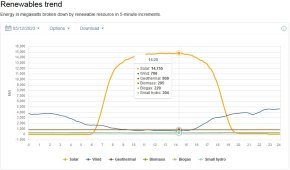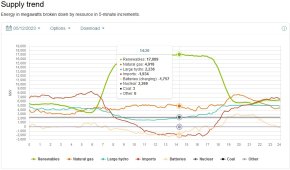OffGridForGood
Catch, make or grow everything you can.
Very good information Wattmatters, I have been following along with your comments, as I see what is occuring in Australia as a kind of crystal ball of our own future on this side of the planet. In my Province (Ontario) we have only 1% solar in the mix so far, but 12% of our electricity is wind.Perhaps. Let's leave it, it's adding no value.
Instead we can all watch the natural experiment taking place here, with South Australia at the vanguard (with other States following closely behind). Next Spring and Summer (Sep-Feb) will be particularly interesting as the grid there pushes beyond 80% VRE and more of the distributed supply and demand control mechanisms take effect.
Last year the State was powered with 73.5% VRE in Spring and 80.1% VRE in Summer. Those are numbers to scare the pants off any grid operator I reckon.
Western Australia has also instituted grid operator remote supply control mechanisms for rooftop PV, and QLD is doing the same, albeit with a far cruder (but reliable) method of using ripple control signals.
Meanwhile electricity distributors here will be introducing new fee structures for power flowing in both directions (up to know all charges have related to power flowing to premises, not from them), but such changes need to be revenue neutral. IOW at times there will be an additional cost for supplying power to the grid when it's not needed. This will come with additional incentive to supply power when it is.
{for interest: Ontario electrical mix per Hydro One 2021; Nueclear 33%, Nat.Gas 29%, Hydro-elect 23%, wind 12%, Solar 1%, biomass 1%} they use the Nat.Gas for peaker plants generally.
I don't hear scare mongering from Utilities on this side of the 49th about "the danger of EV's or solar PV destablizing a fragile grid".
With our low current share of intermittent renewables in the electrical gid (about 14% total as of 2021) I see we are a long way from the situation you have shared from Australia, and why the renewables don't actually cause concern.
Ontario has long been split into two, electrically, however over the last three years, the high voltage grid was upgraded to connect my region (NW) to the main populated part of Ontario (all the rest) allowing for more load sharing both directions, and export of more hydro-electric & solar from the Northern areas to the populated south.
We generally have smart meters and TOU rates available all across the Province, and I believe with controls (like you have described) each home could be both an energy producer or consumer and allow non-critical load shut-downs remotely via signals or other tech to ensure the system as a whole is reliable and efficient well into the future. Exciting times to live in. Thanks for all your comments.





